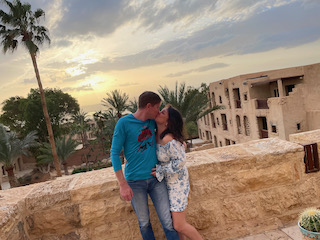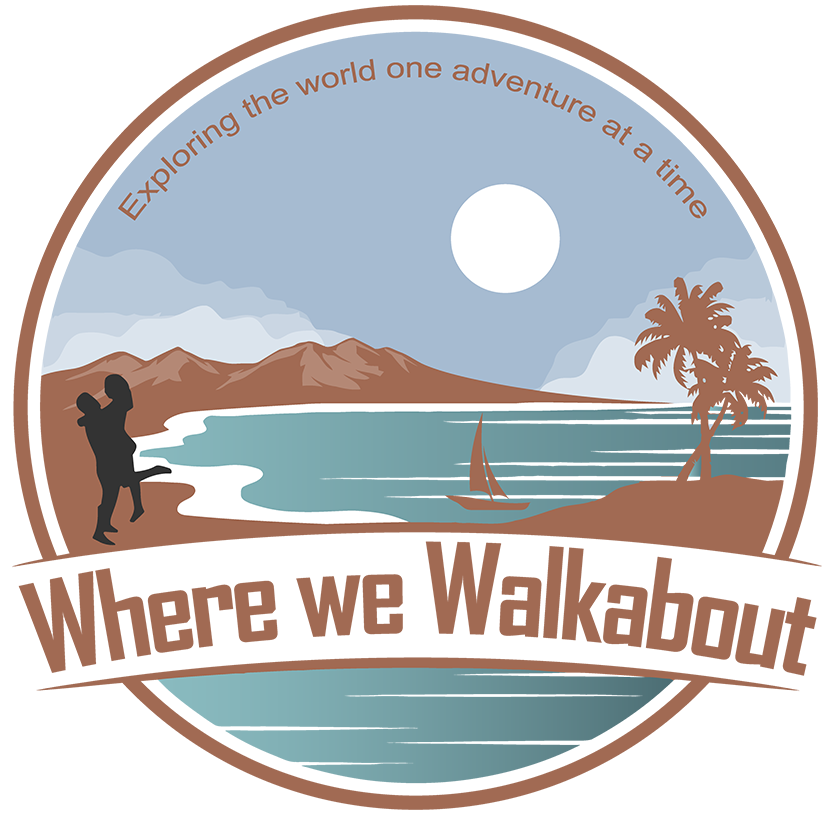Journey Through Jordan
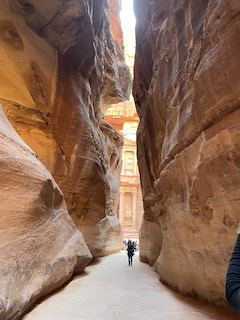
In February of 2022, I was able to realise a lifelong dream of seeing Petra. Of course, Dan being Dan, we didn’t just go to Petra. We saw as much of Jordan as possible! Our itinerary was as follows:
Drive through a sandstorm from Amman to Petra – home of the hidden Treasury and more
After Petra we drove south Wadi Rum – deep desert dunes of the Bedouins home where camels roam.
From Wadi Rum we went north to the Dead Sea – luxury R&R and the historically significant Jordan River.
Read it all, or skip ahead to the part that tempts you the most! I recommend reading everything, of course.
Petra: Beyond the Treasury
If ever you think of Petra, surely it will be associated with the iconic image of the Treasury. This impressive facade has been carved into the red sandstone, pillars and sculptures drawn from Greek Hellenistic culture. It was the one that was in Indiana Jones. It is beautiful, and because it is very easy to get to, it is also the most obvious place to start as a tourist.
To reach it, you walk (or ride a camel, donkey or golf cart) down the to the Treasury. Sheer red walls tower above you, and along the way are ancient carvings made by the Nabateeans. There are ancient water systems in place, built by these people to distribute the water throughout the city. I did a little nosing around at the museum, and it wouldn’t be a stretch to suppose that the Romans learned a lot about their famed aqueducts by observing and building on the techniques used here and throughout the Nabateean empire. But I digress.

originally covered pipes they were destroyed by conquering Romans 2nd century AD
The Siq twists and winds its way, and sudenly opens up into the small plaza-like space in front of the Treasury. There, we were able to sit and enjoy a cup of strong Arabic coffee and enjoy the red colors shift as the sun climbed, banishing the shadows that put into stark relief the beautiful sculptures. There was still a fair amount of tourists and Instagrammers, despite the pandemic but far fewer than usual. A few ledges have been re-purposed into photo destinations, for those in the know (I was not in the know). Its common to dress up, take a golf cart down, pay the 5euro to pose on the famous red carpet with the Treasury in the background. Stunning photos, but not when one is in sensible hiking pants and layers.
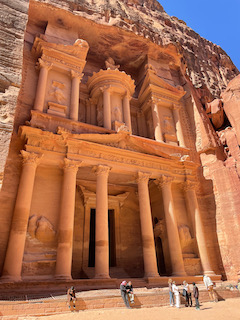
The rest of the day we spent wandering around the valley of tombs beyond the Treasury. There are over 3,000 currently accounted and they range from small and modest (many of these are now thought to be living quarters), to grand and spectacular. These smaller tombs are all around the valley from the floor and up the walls.

One downside was the sheer number of people selling souvenuirs. At first, I thought they were displaced Bedouins, living in the shadow of former empire. But later in the trip I learned, that no, these are gypsies. They sell everything from donkey rides, to scarves. Some of them even sell rocks and aloe vera plants, both of which yes, you can just pick up off the ground. There is a Roman ampitheatre as well (those guys really got everywhere), mosaics, the tombs of the Nabateean Kings (which is at least three times wider than the Treasury). Its an incredibly massive place, and we did not manage to explore all of it in three days.
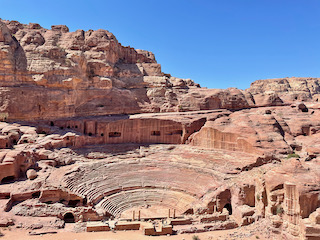


The Place of High Sacrifice is set on the highest cliff. We attempted the walk, but the sheer vertical walls and the tiny steep steps proved too much. Dan has done Machu Picchu and said this was worse. I’ve done Angels Landing in Zion, and this was worse (or maybe we’re just older and wiser). I think if we had gone with a guide, and gone from the proper starting point there would’ve been a chance.
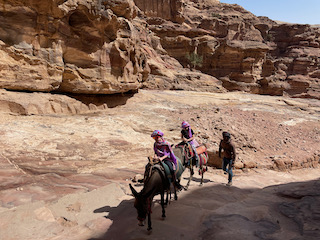
Another hair-raising walk was going to the Monastery from the back of the valley. It can be reached in two ways: from within the valley up a long series of steps and through the gauntlet of hucksters, or to be dropped off in the desert behind the Valley, and walk in over the sand and mountains. We chose the latter, and on our second day, woke up early to start the hike. The early morning air was crisp and cold, and it was very peaceful, with almost no one else in sight. Incredibly tiny and beautiful flowers were blooming along the not very well-marked path. Following stone cairns and having a downloaded trail guide helped a lot.
Once you enter the back of the valley, the familiar red rocks of Petra start to climb up, and up and up. There was a cheerful little coffee stand, with hot Arabic coffee, Tibetan prayer flags, and the piney smell of juniper smoke. After this point, the path narrowed, and continued to climb. A little old lady with a goat left as we approached, and she was ahead of us the entire way. The most exciting bit, was when the path went out around and under an overhanging cliff. One had to hug the wall, or plummet into the desert several hundred meters below. Our goat lady walked around it nonchalantly and disappeared. We paused. It was one of those, ‘we’ve come too far to go back, yes he is serious, I am going to have to do this’ kind of moments There may or may not be a video of me doing this bit on my hands and knees.
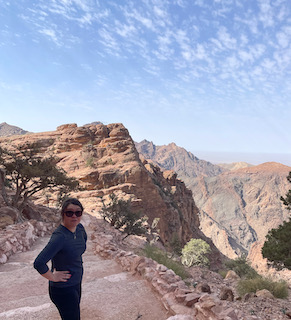

After that, it was mostly business as usual. Looking for the piles of stone cairns so as not to lose the way as the trail flattened out, and then we came up and over a bluff and there was the Monastery. It is HUGE. I cannot understate the immensity. It is not as easy to reach as the Treasury (by a long shot) and it is not as well preserved because it is more exposed to the elements, but if you go all the way to Petra, go to the Monastery.

Wadi Rum: Deep Desert Dunes
If Petra is the ancient, hidden treasure in the craggy rock-strewn desert of Central Jordan, than Wadi Rum is the gateway to the desert of dunes, dreams, and the Arabian nights. The pink and red sands dance between geologic monoliths of incomprehensibly ancient seas, raised up by tectonics that defy all logic. Ancient hieroglyphs are hidden in tiny gullies called wat ratb. For millenia, these hid pockets of reliable water the nomadic Bedouin tribes who roamed the desert that encompasses most of the Arabian penninsula.
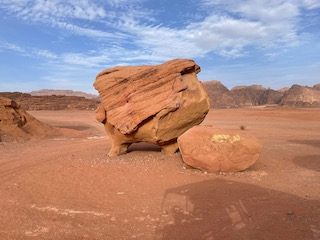
The only way to experience Wadi Rum is to book a tour. There are several companies running these tours, and you can go out just for the day, one night, two or more etc. You can do the Bedouin style tent like we did, or go for the high-end glamping experience in a bubble building. Whichever way you do it, you will see the same major sights on the first day.
Our group piled into the very authentic Bedouin vehicle (Landrover), and we headed into the desert. The first stop was a quick stop to boulder up some rocks and get a sweeping panoramic view of the valley. At the top were a few brave trees, that had managed to grow because of a small natural spring. After that, we headed to one of the highlights, the hieroglyphs. Our guide told us that the glyphs found throughout Wadi Rum dated back to prehistoric times, as early as 4500 BC. They were used to indicate havens from the elements and reliable sources of water. There were symbols that indicated which way to go, and what would be found there. It was lovely and cool between the rocks.
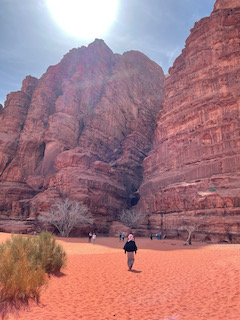
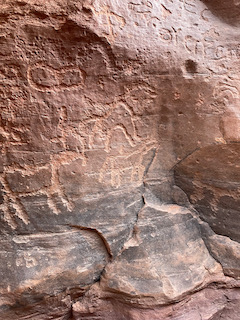
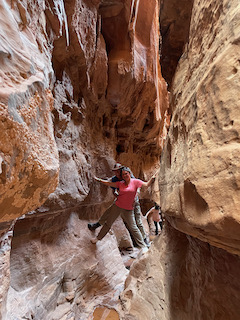
Next stop was a natural bridge. Wadi Rum is full of geologic points of interest; multiple natural bridges, mushroom shaped rocks that rise out of the dunes, enormous that tower over the sands. There is a lot about the stone that remains unexplained to this day. Legend has it, that the famed cities of Soddom and Gomorah once stood there, and a massive tectonic event leveled them, and this is why the rocks of Wadi Rum don’t follow the usual order. Originally the sandstone and granite was a seabed, and has now had millions of years of winds that have created these unusual shapes.
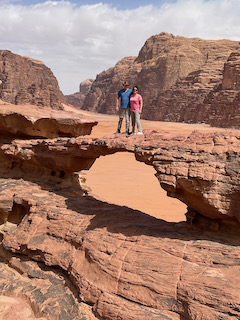
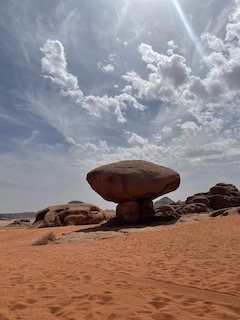
We spent the rest of the day driving around the desert, stopping to hike through canyons and climb up rocks. Everywhere we went was just gorgeous. I could see why directors have been coming here to film movies for the last 60 years. The colors, and the scale of everything takes your breath away – that and the wind. We were lucky enough to be there in February, and it was a bit chilly but I’d rather be cold then hot.
After a few more stops, we headed to the camp. By this point we were all really hungry, as lunch had been hummus, vegetable soup, and pita bread. Dinner was a feast! We were serenaded by the collected guides, and served chicken which had been cooked in the traditional way – a huge iron pot was buried in the sand with burning coals and unearthed with a bunch of fuss for the tourists. After that it was some more Arabic coffee, which is more like a strong sweet tea, with heaps of sugar.
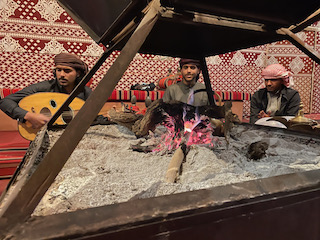
The next day started early, and we had a much smaller group. Everyone except a German couple were leaving, so it was the four of us all day. They were really funny, always laughing and smiling, making lots of poses. It’s always fun to meet people abroad, especially in the more adventurous places. There is a self-selection that almost always guarantees you’ll meet kindred spirits.
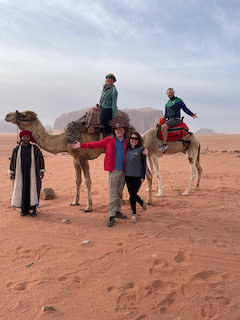
Since we had an earlier start and were already in the desert, we were able to see things that were off the beaten path, with fewer tourists. Although we had stayed the night in a ‘Bedouin-style’ camp and tent, they were clearly built for delicate tourists, rather than desert nomads. Today, we went to a real Bedouin camp, where we had lunch and of course, Arabic coffee. These were humble dwellings, made of rope and blankets. The goats wandered around camp, and there were a few more hieroglyphs on a nearby rockface.

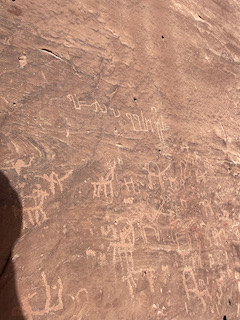
They also had a lot of camels! This was quite a highlight, because we didn’t just get to see them, but were able to feed them and pet them and had the option of drinking milk, fresh from the teat. As the food was fresh and green, the camels were quite frisky. They ranged in color from caramel to a beautiful cream color, and the babies had incredibly soft fur. They weren’t shy at all, and our guide showed us that it was quite safe to let them nibble at your fingers. Also, we learned that the collective noun for camels, is a caravan. Rolls off the tongue nicely I think.

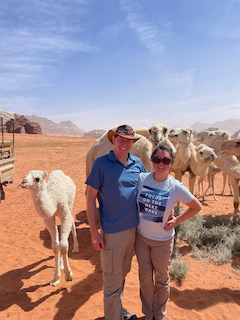
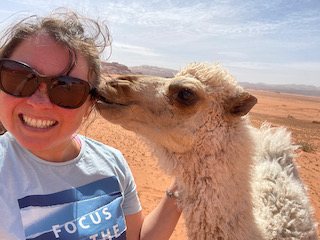
Next up, we were driven to a formation of rocks that looked out over the border to Saudi Arabia. We were close enough that my cell phone provider kept switching back and forth between the Jordanian network and the Saudi one. The vista here was amazing, and we were met by our guide’s cousin and his group as well. There was the chance to go sandboarding, and the two guides showed off doing backflips as they raced down the dune face. At sunset we stopped to take in the view and have some more Arabic coffee, with camel milk! It had a very strong flavor. We also had asked our guide to not put the sugar in, which he viewed as an absolute travesty. He built up a small fire and placed the pot directly into it, using a stick to manage the fire around and lift it out of the flames.

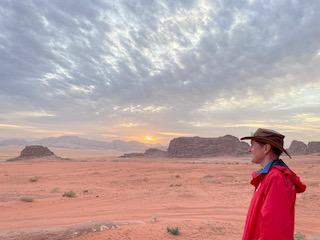
All in all, it was as authentic an experience as one could expect. There were unavoidable elements of the modern day tourist industry, but I left with a respect for desert nomads I hadn’t had before. The elements are truly brutal, and you live at their mercy. But the landscape is beautiful, and it was clear that our guide was very proud to live there, and be a true Bedouin, with history that goes back thousands of years. I imagine life stayed very much the same until quite recently. I don’t think there has ever been a fat Bedouin.
Dead Sea: Luxury and History
One of the many unique things about Jordan, is that despite it’s seemingly remote location, it was a crossroads for empires and cultures for thousands of years. It doesn’t have a coastline, but is close enough to the Mediterreanean sea. Anyone travelling by land from Northern Africa to Turkiye, and Europe would pass through Jordan. It had a rich and influential empire before the Romans came, and was occupied by several different empires since. It is also a place of religious significance where you can walk in the footsteps of Moses, John the Baptist, and Jesus Christ.
We visited one of these sites, known as Bethany-Beyond-Jordan which is believed to be where John the Baptist baptised Jesus in the River Jordan. The river meanders along, a shadow of its former self due to irrigation and farming. It defines the border between Israel and Jordan, and both countries have a strong presence here. It was very startling to be in a place of such holy significance, with armed guards. The Jordanian side had gone for a rustic traditional look, with a cistern for babies to be baptised in, as well as a dock where adults could go to be re-baptised in the waters.
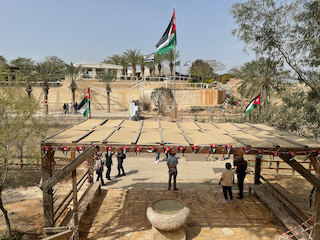
Our guide was very diplomatic in explaining the ins and outs of the political situations, and the significance of the location for all three monotheistic religions. When one of the members of our group asked him about his personal religion of choice, he very tactfully replied “I believe in God”. He also told us about some of the recent archaelogical findings on the Jordanian side of the river. Recently discovered, and unearthed was what they believe was the true site of the baptism. Because the river used to flood and recede annually, its path to the Dead Sea would change from year to year. The path it follows now, is not the same as 2000 years ago, and because of agricultural irrigation, it barely even reaches the sea.
Inn 1994, a peace treaty was reached between Israel and Jordan. So they were able to get rid of the minefield that was previously along the border and begin excavation of the area. In 1996, near a freshwater stream that fed into the river, they found the structure that is now commonly accepted as the place where the baptism happened.

Although I am not personally a religious person, there is something about being in a place that means so much to so many. Seven of the people in the group had travelled from Alabama, sponsored by their church, to be re-baptised in the river. Our guide obviously had a deep respect and understanding of it all. Even the amount of security served to re-inforce the importance of where we were.
But there is a lot to do in the Dead Sea that doesn’t involve such heavy topics. For example, swimming! We were lucky enough that the resort we stayed in had steps leading down to the sea itself, and at the shore, there were urns full of the famous mud and salt. Dead Sea products are sold all over the world, so of course we had to try it. A lifeguard explained to us the process. First, you hop in the sea (do NOT get the water in your eyes). Second, you cover yourself in mud and let it dry on your skin. Then you hop into the water again to rinse off, and when you come out you scrub your body down with the salt. Don’t ask me the exact mineral composition, but I can confirm that my skin felt baby soft after the process.
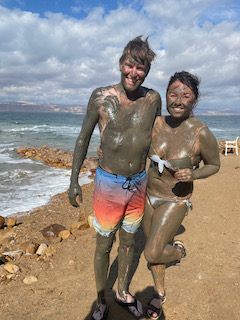

We also visited a museum located at the top of the valley, the Panorama Dead Sea Complex. It has a jaw-dropping view of the valley, and offers a wealth of information about the non-religious aspects of the Dead Sea. This included information about the mineral composition, as well as the evolution of the sea. I won’t bored you with the details, but much like the rest of Jordan, it has been subjected to tectonic forces and happens to also be the lowest body of water on earth, as well as the lowest point on earth. There was also a restaurant where we indulged in a cheeky mid-day glass of wine while enjoying the view.
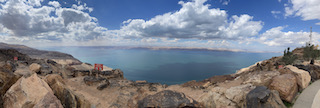

Heading back to the resort we were welcomed back in the lobby by a man handing out, you guessed, Arabic coffee. As it was COVID times, he had a mask on but removed it for the sake of a photo. It was such an intricate contraption, and as always, the coffee was strong and sweet.

We enjoyed a stunning sunset from the balconey of the main hotel, and then went for dinner at one of the restaurants in the resort. It was styled like a small town, with stone buildings with larger apartments around plazas with restaurants and cafe’s and shops. Most of these were closed, because there was simply almost no one there. One plaza was open, and we ate al fresco while a belly dancer entertained us and the few other visitors.
It was a nice way to finish the trip. I feel like we really got to see many different sides of Jordan, and learned a lot about it’s people. The south has a very strong desert vibe, but as we went north orchards began to appear and the landscape, while still harsh, was more cultivated. Everyone we met was warm and friendly, and the food was healthy. I discovered zataar on this trip, and bought 500g of it in Amman to bring home. It is one of my favorite trips we have done.
